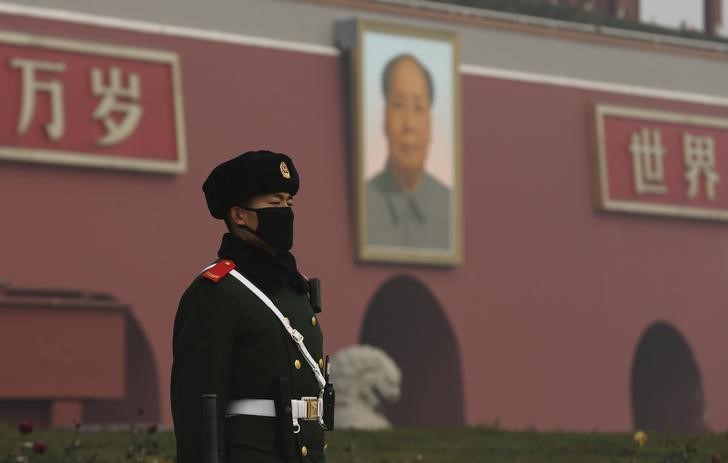(Bloomberg) -- China’s top policy makers meet next week to hammer out the country’s future economic blueprint, offering clues on how the leadership plans to pivot the world’s second-largest economy to be more self-sufficient.
The four-day meeting of the Communist Party’s Central Committee will take place behind closed doors from Monday in Beijing. Known as the plenum, the discussion this year will focus on the framework for China’s 14th five-year plan that runs from 2021 through 2025, as well as the vision and targets for the next 15 years.
The finalized plan won’t be made public before being formally approved by China’s legislature, the National People’s Congress, in March. However, some of the details may emerge via state media once the plenum ends.
Facing heightened tensions with the U.S. and a virus-battered world economy in recession, a central question around the plenum will be how China can draw on domestic sources to sustain its growth.
Here are some key themes investors are watching out for and how they’re trading on the information:
Dual Circulation
In the coming five years, policies are expected to be formulated around the idea of “dual circulation” raised by President Xi Jinping, in which China is seeking to create a more self-reliant domestic economy supplemented by external trade. Domestically, the strategy would require China reshaping its production to satisfy local demand and bolster consumption.
What Bloomberg’s Economists Say
“An emphasis on encouraging domestic circulation would not signal that China is closing its doors on the world. We expect the plan to encourage two-way trade and promote services trade.”
Click here to read the full report.
Chang Shu, chief Asia economist
On the external side, China is likely to continue opening up its markets, including easing restrictions that bar foreign investors from certain industries -- known as the negative list -- and lowering tariffs and non-tariff barriers on imports.
Growth Target (NYSE:TGT)
Analysts are watching closely whether officials will set a specific target for gross domestic product growth in the five-year plan or give a broad description of the goal. The government didn’t set an annual growth target this year amid the uncertainty unleashed by the coronavirus pandemic. The previous five-year plan set an average growth target of above 6.5%.
“Current market estimates are for a growth target in the range of 5-5.5%, while we think 5% would be a reasonable number, with China needing 4.5% annual GDP growth to achieve high income status by 2025,” Morgan Stanley (NYSE:MS) economists led by Robin Xing wrote in a note this week.
2035 Blueprint
This year’s plenum will also feature discussions around China’s economic trajectory over the next 15 years. The 19th Party Congress in 2017 set out a vision for China as a “modern power” by 2050, with the first stage of that process running from 2020-2035, focusing on areas like technology innovation, expanding the middle-income group, and improving the environment.
“For the 2035 blueprint, it indicates that China’s policy making becomes more long-term oriented, and that investors could expect more continuity and certainty of policies in the upcoming 15 years,” said Liu Peiqian, China economist at Natwest Markets Plc in Singapore. “However, it is more of a political guideline than a basket of detailed measures. The wording of it might look vaguer compared to the five-year plan.”
Technology Innovation
Beijing has made no secret of its ambitions to vault into the upper echelons of technology -- in fields from artificial intelligence to semiconductors and next-generation networking -- but those objectives will garner more attention than ever before at a time of intensifying rivalry with the U.S.
Read More: The U.S.-China Conflict Over Chips Is About to Get Uglier
Global industry watchers will scrutinize Beijing’s blueprint for details on how it plans to funnel investment into cutting-edge fields from so-called third-generation chip-making to quantum computing and AI applications. Outside of China, tech players will be watching for hints of strengthening techno-nationalism: whether the country is considering opening up its long-shuttered internet industry, for instance, or intends to further tighten its grip on online content and the phenomenal amounts of data critical to training AI algorithms and supporting domestic innovation.
Carbon Goals
Xi’s surprise announcement last month that the world’s biggest polluter plans to be carbon neutral by 2060 has upended energy policy in a country that relies on coal for more than half its power.
The five-year plan may see China accelerate its adoption of clean energy. The current goal is to derive as much as 20% of primary energy use from non-fossil fuels by 2030, but one option under consideration is to bring forward that target to 2025, people familiar with the discussions told Bloomberg last month. That would require a major increase in wind and solar installations over the five years.
Market Watch
The prospect of five-year plans can fuel speculative stock buying. Chinese renewable energy stocks surged last month on bets Beijing may lift its targets for wind and solar installations during 2021-2025. Xinjiang Goldwind Science & Technology Co. and GCL-Poly Energy Holdings Ltd. jumped in mid-September, weeks before Xi announced his carbon neutral goal.
Other areas seen likely to get policy backing in the next five years include technology, finance and defense, according to Bloomberg Intelligence and Chinese brokerages including China Galaxy Securities Co. Stocks are broadly higher ahead of the meeting, with the MSCI China Index up more than 6% this month and trading near its highest level in 23 years.
In 2015, child-care-related stocks such as infant formula makers and toy manufacturers surged after China ended its one-child policy as part of a five-year plan through 2020.
©2020 Bloomberg L.P.
